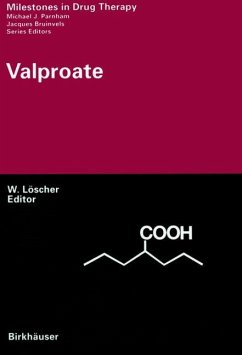Valproic acid was first synthesized in 1882 by Burton, but there was no known clinical use until its anticonvulsant activity was fortuitously discovered by H. Meunier in 1963 in the laboratory of G. Carraz. The first clinical trials of the sodium salt of valproate were reported in 1964 by Carraz. It was marketed in France in 1967 and was released in the United States in 1978 for the treatment of epilepsy. Since then, valproate has established itself worldwide as a major antiepileptic drug against several types of seizures. Clinical experience with valproate has continued to grow in recent years, including use of valproate for diseases other than epilepsy, for example in bipolar disorders and migraine. In this book, emphasis is placed on the scientific background leading to the discovery of valproate and its clinical development into one of the most widely and successfully used antiepileptic drugs, a real milestone in drug therapy. The current state of knowledge of valproate is reviewed by experts in the field, including new hypotheses on its mechanisms of action, its metabolism into pharmacologically active metabolites, its unique distribution characteristics, its undesirable hepatotoxic and teratogenic adverse effects, and its various clinical uses. The monograph is aimed at a broad readership, particularly neurologists, psychiatrists and basic scientists working in the field of epilepsy research. Furthermore, the book also deals with structure-activity relationships of valproate as well as of its metabolites and analogs and should therefore attract researchers working in medicinal chemistry.
Since the fortuitous discovery of its anticonvulsant activIty in 1962, valproate has established itself worldwide as a major antiepileptic drug against several types of epileptic seizures. Clinical experience with valpro ate has continued to grow in recent years, including use of valproate for diseases other than epilepsy, for example in bipolar disorders and migraine. In this volume on valproate emphasis is placed on the scientific back ground leading to the discovery of val pro ate, its subsequent pharmacologi cal and toxicological characterization, and its clinical development into one of the most widely and successfully used anti epileptic drugs, a real mile stone in drug therapy. The current state of knowledge of valproate will be reviewed by experts in the field, including new hypotheses about its mecha nisms of action, its metabolism into pharmacologically active metabolites, its unique distribution characteristics, its unwanted hepatotoxic and terato genic adverse effectsand its various clinical uses. Furthermore, the wide variety of available pharmaceutical formulations of valproate, including novel controlled-release formulations, will be outlined. The monograph is aimed at a broad readership, particularly neurologists, psychiatrists and basic scientists working in the field of epilepsy research. Because the monograph also deals with structure-activity relationships of valproate as well as of its metabolites and analogs, the book should also serve for rese archers working in medicinal chemistry, particularly in the pharmaceutical industry.
Since the fortuitous discovery of its anticonvulsant activIty in 1962, valproate has established itself worldwide as a major antiepileptic drug against several types of epileptic seizures. Clinical experience with valpro ate has continued to grow in recent years, including use of valproate for diseases other than epilepsy, for example in bipolar disorders and migraine. In this volume on valproate emphasis is placed on the scientific back ground leading to the discovery of val pro ate, its subsequent pharmacologi cal and toxicological characterization, and its clinical development into one of the most widely and successfully used anti epileptic drugs, a real mile stone in drug therapy. The current state of knowledge of valproate will be reviewed by experts in the field, including new hypotheses about its mecha nisms of action, its metabolism into pharmacologically active metabolites, its unique distribution characteristics, its unwanted hepatotoxic and terato genic adverse effectsand its various clinical uses. Furthermore, the wide variety of available pharmaceutical formulations of valproate, including novel controlled-release formulations, will be outlined. The monograph is aimed at a broad readership, particularly neurologists, psychiatrists and basic scientists working in the field of epilepsy research. Because the monograph also deals with structure-activity relationships of valproate as well as of its metabolites and analogs, the book should also serve for rese archers working in medicinal chemistry, particularly in the pharmaceutical industry.








